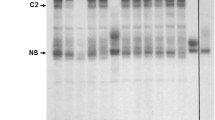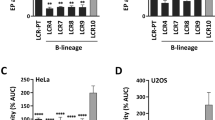Summary
The stimulatory effects of the 13S adenovirus E1A gene product on the human cytomegalovirus (HCMV) major immediate early (IE) enhancer were examined. Chimeric plasmids containing cloned portions of the HCMV major IE enhancer-promoter positioned upstream of the chloramphenicol acetyltransferase gene (cat) were cotransfected into HeLa cells with the plasmid p13S-wt which contained a cDNA encoding the adenovirus 13S E1A gene product. CAT expression from chimeric plasmids containing at least one copy of the HCMV 19 base pair (bp) repetitive motif was stimulated 10-fold in the presence of p13S-wt. The 19-bp motif contains a potential binding site for the cellular transcription factor ATF/CREB. Deletion analysis indicated that the ATF/CREB site was crucial for E1A-mediated stimulation. Insertion of a synthetic oligonucleotide homologous to a 19-bp motif and containing an ATF/CREB binding site into an HCMV chimera lacking ATF/CREB motifs conferred E1A responsivity on HCMV promoter-mediated CAT expression whereas insertion of a similar oligonucleotide containing a change of two bases in the sequence of the ATF/CREB site did not. Measurement of CAT-specific RNA verified the results of the CAT enzyme experiments. The ATF/CREB motif may be a target for stimulation of HCMV gene expression through either viral or cellular transcription factors.
Similar content being viewed by others
References
Alton NK, Vapnek D (1979) Nucleotide sequence analysis of the chloramphenicol resistance transposon Tn9. Nature 282: 864–869
Berk AJ (1986) Adenovirus promoters and E1A transactivation. Ann Rev Genet 20: 45–79
Berk AJ, Lee F, Harrison T, Williams J, Sharp P (1979) Pre-early adenovirus 5 gene product regulates synthesis of early viral messenger RNAs. Cell 17: 935–944
Boshart M, Weber F, Jahn G, Dorsch-Hasler K, Fleckenstein B, Schaffner W (1985) A very strong enhancer is located upstream of an immediate early gene of human cytomegalovirus. Cell 41: 521–530
Burzio LO, Zarraga AM, Saddiqui MAQ (1986) A rapid and sensitive assay procedure for chloramphenicol acetyl transferase: application to eukaryotic gene promoter function. Gene Anal Tech 3: 93–95
Chatterjee PK, Bruner M, Flint SJ, Harter ML (1988) DNA-binding properties of an adenovirus 289 R E1A protein. EMBO J 7: 835–841
Chirgwin JM, Przybyla AE, MacDonald RJ, Rutter WJ (1979) Isolation of biologically active ribonucleic acid from sources enriched in ribonuclease. Biochemistry 18: 5294–5299
Demarchi JM, Schmidt CA, Kaplan AS (1981) Patterns of transcription of human cytomegalovirus in permissively infected cells. J Virol 35: 277–286
Ferguson B, Krippl B, Andrisani O, Jones N, Westphal H, Rosenberg M (1985) E1A 13S and 12S mRNA products made inEscherichia coli both function as nucleus-localized transcription activators but do not directly bind DNA. Mol Cell Biol 5: 2653–2661
Fiala M, Payne JE, Berne TV, Moore TC, Henle W, Montgomerie JZ, Chatterjee SN, Guze LB (1975) Epidemiology of cytomegalovirus infection after transplantation and immunosuppression. J Infect Dis 132: 421–433
Garcia J, Wu F, Gaynor R (1987) Upstream regulatory regions required to stabilize binding to the TATA sequence in an adenovirus early promoter. Nucleic Acids Res 15: 8367–8385
Gendelman HE, Phelps W, Feigenbaum L, Ostrove JM, Adachi A, Howley PM, Khoury G, Ginsberg HS, Martin MA (1986) Transactivation of the human immunodeficiency virus long terminal repeat sequence by DNA viruses. Proc Natl Acad Sci USA 83: 9759–9763
Ghazal P, Lubon H, Fleckenstein B, Hennighausen L (1987) Binding of transcription factors and creation of a large nucleoprotein complex on the human cytomegalovirus enhancer. Proc Natl Acad Sci USA 84: 3658–3662
Ghazal P, Lubon H, Hennighausen L (1988) Multiple sequence-specific transcription factors modulate cytomegalovirus enhancer activity in vitro. Mol Cell Biol 8: 1809–1811
Gilardi P, Perricaudet M (1986) The E4 promoter of adenovirus type 2 contains an E1a dependent cis-acting element. Nucleic Acids Res 14: 9035–9049
Gorman CM, Gies D, McCray G, Huang M (1989) The human cytomegalovirus major immediate early promoter can be trans-activated by adenovirus early proteins. Virology 171: 377–385
Gorman CM, Moffat LF, Howard BH (1982) Recombinant genomes which express chloramphenicol acetyltransferase in mammalian cells. Mol Cell Biol 2: 1044–1051
Hanaka S, Nishigaki T, Sharp P, Handa H (1987) Regulation of in vitro and in vivo transcription of early-region IV of adenovirus type 5 by multiplecis-acting elements. Mol Cell Biol 7: 2578–2587
Hardy S, Shenk T (1988) Adenoviral control regions activated by E1a and the cAMP response element bind to the same factor. Proc Natl Acad Sci USA 85: 4171–4175
Hennighausen L, Fleckenstein B (1986) Nuclear factor I interacts with five DNA elements in the promoter region of the human cytomegalovirus major immediate early gene. EMBO J 5: 1367–1371
Hermiston TW, Malone CL, White PR, Stinski MF (1987) Identification and characterization of the human cytomegalovirus immediate-early region 2 gene that stimulates gene expression from an inducible promoter. J Virol 61: 3214–3221
Hunninghake GW, Monick MM, Liu B, Stinski MF (1989) The promoter-regulatory region of the major immediate-early gene of human cytomegalovirus responds to T-lymphocyte stimulation and contains functional cyclic AMP-response elements. J Virol 63: 3026–3033
Imperiale MJ, Nevins JR (1985) Adenovirus 5 E2 transcription unit: an E1A-inducible promoter with an essential element that functions independently of position or orientation. Proc Natl Acad Sci USA 82: 875–882
Jahn G, Knust E, Schmolla H, Sarre T, Nelson JA, McDougall JK, Fleckenstein B (1984) Predominant immediate-early transcripts of human cytomegalovirus AD 169. J Virol 49: 363–370
Jones N, Shenk T (1979) An adenovirus type 5 gene function regulates expression of other early viral genes. Proc Natl Acad Sci USA 76: 3665–3669
Lee KAW, Green MR (1987) A cellular transcription factor, EAF1 interacts with an E1A-inducible enhancer and mediates constitutive enhancer function in vitro. EMBO J 6: 1345–1353
Lee KAW, Hai T-Y, SivaRaman L, Thimmappaya B, Hurst HC, Jones NC, Green MR (1987) A cellular protein, activating transcription factor, activates transcription of multiple E1A inducible adenovirus early promoters. Proc Natl Acad Sci USA 84: 8355–8359
Leff T, Elkaim J, Sassone-Corsi P (1985) Transcriptional analysis of the adenovirus 5 EIII promoter: absence of sequence specificity for stimulation by E1A gene products. Nucleic Acids Res 13: 1209–1221
Leza MA, Hearing P (1988) Cellular transcription factor binds to the adenovirus early region promoters and to a cyclic AMP response element. J Virol 62: 3003–3013
Lin Y-S, Green MR (1988) Interaction of a common cellular transcription factor, ATF, with regulatory elements in both E1A- and cyclic AMP-inducible promoters. Proc Natl Acad Sci USA 85: 3396–3400
Lopata MA, Cleveland DW, Sollner-Webb B (1984) High level transient expression of a chloramphenicol acetyltransferase gene by DEAE-dextran mediated DNA transfection coupled with a dimethyl sulphoxide or glycerol shock treatment. Nucleic Acids Res 12: 5707–5717
Maniatis T, Fritsch EF, Sambrook J (1982) Molecular cloning. A laboratory manual. Cold Spring Harbor Laboratory, Cold Spring Harbor, NY
McDonough SM, Spector DH (1983) Transcription in human fibroblasts permissively infected by human cytomegalovirus strain AD 169. Virology 125: 31–46
Montminy MR, Sevarino KA, Wagner JA, Mandel G, Goodman RH (1986) Identification of a cyclic AMP-responsive element within the rat somatostatin gene. Proc Natl Acad Sci USA 83: 6682–6686
Moran E, Zerler B, Harrison TM, Mathews MB (1986) Identification of separate domains in the adenovirus E1A gene for immortalization activity and the activation of virus early genes. Mol Cell Biol 6: 3470–3480
Murthy SCS, Bhat GP, Thimmappaya B (1985) Adenovirus EIIA early promoter: transcriptional control elements and induction of the viral pre-early E1A gene, which appears to by sequence independent. Proc Natl Acad Sci USA 82: 2230–2234
Nelson JA, Reynolds-Kohler C, Smith B (1987) Negative and positive regulation by a short segment in the 5′-flanking region of the human cytomegalovirus major immediate-early gene. Mol Cell Biol 7: 4125–4129
Nevins JR (1987) Mechanism of activation of early viral transcription by the adenovirus E1A gene product. Cell 26: 213–220
Olive DM, Simsek M, Al-Mufti (1989) Polymerase chain reaction assay for the detection of human cytomegalovirus. J Clin Microbiol 27: 1238–1242
Olive DM, El-Mekki A, Al-Mulla W, Kobryn A, Khalik DA, Al-Nakib W (1988) The use of ELISA and non-radioactive DNA hybridization assays for the detection of human cytomegalovirus. J Virol Methods 19: 289–298
Pass RF, Stagno S, Britt WJ, Alford CA (1983) Specific cell-mediated immunity and the natural history of congenital infection with cytomegalovirus. J Infect Dis 148: 953–961
Rigby PJW, Dieckman M, Rhodes C, Berg P (1979) Labeling deoxyribonucleic acid to high specific activity in vitro by nick-translation with DNA polymerase. J Mol Biol 113: 237–251
Sanger F, Nicklen S, Coulson AR (1977) DNA sequencing with chain-terminating inhibitors. Proc Natl Acad Sci USA 74: 5463–5467
Seldon R (1988) Analysis of DNA sequences by blotting and hybridization. In: Ausubel FM, Brent R, Kingston RE, Moore DD, Seidman JG, Smith JA, Struhl K (ed) Current protocols in molecular biology, vol 1. Wiley, New York, pp 2.9.1–2.9.7
Silver BJ, Bokar JA, Virgin JB, Vallen EA, Milsted A, Nilson JH (1987) Cyclic AMP regulation of the human glycoprotein hormone α-subunit gene is mediated by an 18-base-pair element. Proc Natl Acad Sci USA 84: 2198–2202
Simon MC, Fisch TM, Benecke BJ, Nevins JR, Heintz N (1988) Definition of multiple, functionally distinct TATA elements one of which is a target in the hsp 70 promoter for E1A regulation. Cell 52: 723–729
Spector DJ, Tevethia MJ (1986) Identification of a human cytomegalovirus virus DNA segment that complements an adenovirus 5 immediate early mutant. Virology 151: 329–338
van Ormont H, Maat J, Dijkema R (1979) Comparison of nucleotide sequences of the early E1A regions for subgroups A, B, and C of human adenoviruses. Gene 12: 63–76
Wathen MW, Stinski MF (1982) Temporal patterns of human cytomegalovirus transcription: mapping the viral RNAs synthesized at immediate early, early, and late times after infection. J Virol 41: 462–477
Wu L, Berk AJ (1988) Constraints on spacing between transcription factor binding sites in a simple adenovirus promoter. Genes Dev 2: 403–411
Wu L, Berk AJ (1988) Transcriptional activation by the pseudorabies virus immediate early protein requires the TATA box element in the adenovirus 2 E1B promoter. Virology 167: 318–322
Wu L, Rosser DSE, Schmidt MC, Berk AJ (1987) A TATA box implicated in E1A transcriptional activation of a simple adenovirus 2 promoter. Nature 326: 512–515
Yanisch-Perron C, Vieira J, Messing J (1985) Improved M 13 phage vectors and host strains: nucleotide sequences of the M 13 mp 18 and pUC 19 vectors. Gene 33: 103–119
Author information
Authors and Affiliations
Rights and permissions
About this article
Cite this article
Olive, D.M., Al-Mulla, W., Simsek, M. et al. The human cytomegalovirus immediate early enhancer-promoter is responsive to activation by the adenovirus-5 13S E1A gene. Archives of Virology 112, 67–80 (1990). https://doi.org/10.1007/BF01348986
Received:
Accepted:
Issue Date:
DOI: https://doi.org/10.1007/BF01348986




